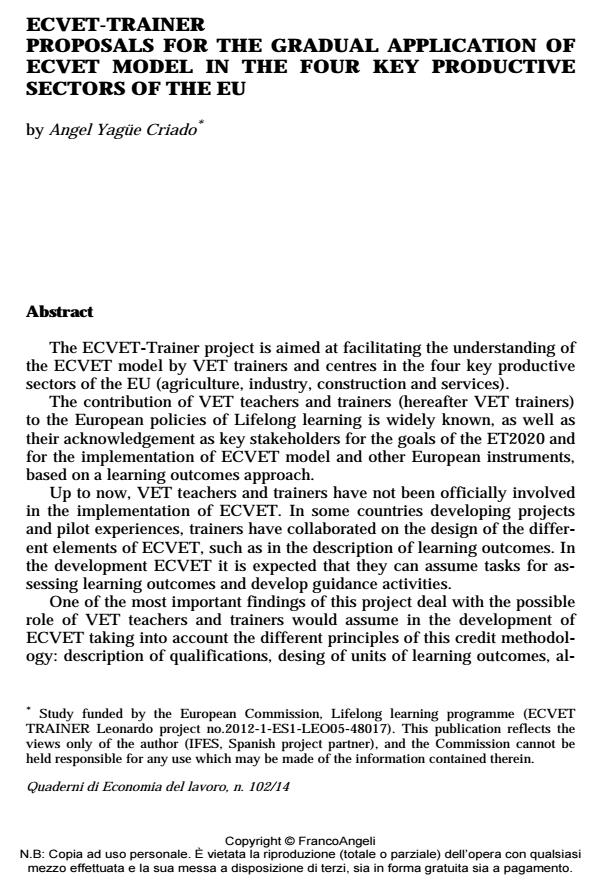ECVET-trainer proposals for the gradual application of ECVET model in the four key productive sectors of the EU
Journal title QUADERNI DI ECONOMIA DEL LAVORO
Author/s Angel Yagüe Criado
Publishing Year 2015 Issue 2014/102
Language Italian Pages 6 P. 65-70 File size 23 KB
DOI 10.3280/QUA2014-102007
DOI is like a bar code for intellectual property: to have more infomation
click here
Below, you can see the article first page
If you want to buy this article in PDF format, you can do it, following the instructions to buy download credits

FrancoAngeli is member of Publishers International Linking Association, Inc (PILA), a not-for-profit association which run the CrossRef service enabling links to and from online scholarly content.
The ECVET-Trainer project is aimed at facilitating the understanding of the ECVET model by VET trainers and centres in the four key productive sectors of the EU (agriculture, industry, construction and services). The contribution of VET teachers and trainers (hereafter VET trainers) to the European policies of Lifelong learning is widely known, as well as their acknowledgement as key stakeholders for the goals of the ET2020 and for the implementation of ECVET model and other European instruments, based on a learning outcomes approach. Up to now, VET teachers and trainers have not been officially involved in the implementation of ECVET. In some countries developing projects and pilot experiences, trainers have collaborated on the design of the different elements of ECVET, such as in the description of learning outcomes. In the development ECVET it is expected that they can assume tasks for assessing learning outcomes and develop guidance activities. One of the most important findings of this project deal with the possible role of VET teachers and trainers would assume in the development of ECVET taking into account the different principles of this credit methodology: description of qualifications, desing of units of learning outcomes, allocation of ECVET points, collaboration with competent institutions, participation in the Memorandum of Understanding and development of Learning agreements, assessment of learning outcomes and their contribution in the relation between ECVET and ECTS methodologies.
- Cedefop (2011). The Development of ECVET in Europe. Working Paper, 14.
- Cedefop (2012). Necessary Conditions for ECVET Implementation.
- Ecvet team (2011). User Guide Part 1: Get to Know ECVET Better – Questions and Answers.
- Ecvet team (2012). User Guide Part 2: Using ECVET for Geographical Mobility (2012).
- Ecvet team (2012). User Guide Part 3: Using ECVET to Support Lifelong Learning (2012). Ecvet team. tool-kit: http://www.ecvet-toolkit.eu.
- Ecvet team.Pilot Projects: http://www.ecvet-projects.eu/.
- European Commission (2009): Recommendation of the European Parliament and of the Council of 18 June 2009 (2009/C 155/02) on the establishment of a European Credit System for Vocational Education and Training (ECVET).
- Finnish National Board of Education. (2012) Finecvet as a Pioneer. www.finecvet.fi Getting the credit your learners deserve: How to recognise achievements during European mobility periods (2013)
- Kari Koskela (2014). ECVET – implementation in Finland. Ecvet-Trainer Project.
- Let´s Go Europe (2012)! Guidelines for the application of ECVET in the course of mobility periods in VET.
- Michel Aribaud (2014). ECVET team. Involving teachers and trainers in implementing ECVET: new ways of working. ECVET Magazine, 20.
Angel Yagüe Criado, ECVET-trainer proposals for the gradual application of ECVET model in the four key productive sectors of the EU in "QUADERNI DI ECONOMIA DEL LAVORO" 102/2014, pp 65-70, DOI: 10.3280/QUA2014-102007